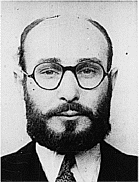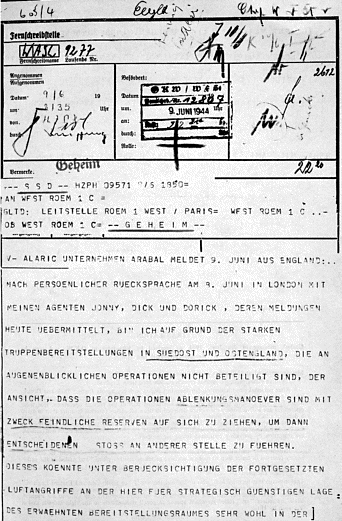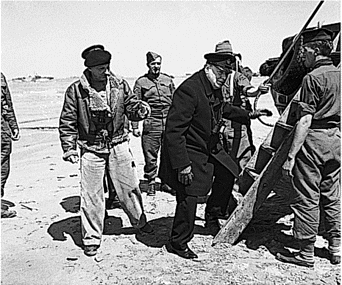Churchill's Wizards (57 page)
Read Churchill's Wizards Online
Authors: Nicholas Rankin


24 Barcelona-born Juan Pujol GarcÃa, the most successful double agent of WW2. Code-named garbo by the British (because he was such a good actor), he was decorated by Germany with the Iron Cross for leading the extensive alaric spy ring in Britain, which was in fact wholly imaginary and coordinated with Allied strategic deception.

25 Juan Pujol's crucial message as received by teleprinter at German HQ on 9 June 1944. As top German V-Man or Agent arabal he suggested that the D-Day landings were a diversion from the real attack, which convinced Hitler to hold back nineteen divisions at Calais, thus saving the Normandy invasion.

26 Prime Minister Winston Churchill sets foot in liberated France on 12 June 1944, six days after D-Day. The Normandy beachhead was not yet wholly secured and his wizards had to keep their spell working for many more weeks to achieve the triumphant apotheosis of British military deception in the twentieth century.
Carl von Clausewitz's
Vom Kriege
first appeared in 1832, and the Everyman
On
War
was edited and translated by Michael Howard and Peter Paret in 1976. Thomas Hobbes's
Leviathan
was published in 1651. Quotes come from Alan Lascelles's diaries
The End of an Era
(1986), Raymond Seitz's memoir
Over Here
(1998), Richard Eyre's history
Changing Stages: a view of British Theatre in th
e
20th Century
(2000), Geoffrey Household's novel
Watcher in the Shadows
(1960), Jorge Luis Borges's fiction âTlön, Uqbar, Orbis Tertius' (1941) and Sun Tzu's military manual,
The Art of War
, translated by Lionel Giles (1910). The Prophet's
hadith
, cited in
The Encyclopaedia of Islam
in the British Library, is to be found in the
Sahih
of al-Bukhari, vol. 4, book 52, nos 267, 268 and 269. An entire 1971 book by William Woodin Rowe is dedicated to
Nabokov's Deceptiv
e
World
and Vladimir Nabokov's autobiography
Speak
,
Memory
(1966) has a superbly lyrical description of Batesian mimicry, confirming the observation in the writer's 1964 commentary on
Eugene Onegin
: âArt is a magical deception, as all nature is magic and deception.' Two British historians who have noted the contrast between Britain's size and its standing are Linda Colley and David Cannadine; see their respective
Captives: Britain, Empire and the Worl
d
1600â1850
(2002) and
Ornamentalism: how the British saw their Empire
(2001). Among copious Churchilliana, Martin Gilbert's biographical work is indispensable: the paperback
Churchill: a life was
always to hand, Violet Bonham Carter's
Winston Churchill As I Knew Him
(1965) is full of insight, and
Speakin
g
for Themselves: the personal letters of Winston and Clementine Churchill
(1998), edited by their daughter Mary Soames, is fascinating. Winston Churchill's account of the Downing Street tea-party comes from
The World Crisis
, his tremendous history of the First World War from 1911 to 1922, published in five volumes between 1923 and 1932, where the
Most Secret
memo âThe Dummy Fleet' appears in Appendix E of volume 1. There is a picture of SS
Merion
before and after its transformation into a dummy battleship on pp. 168â9 of
The Imperia
l
War Museum Book of the First World War
(1991) by Malcolm Brown.
The books by Sir Philip Gibbs I used were
The Soul of the War
(1915),
Realitie
s
of War
(1920),
Life's Adventure
(1957) and
The War Dispatches
, edited and introduced by his son Anthony in 1966. Gibbs reported the Western Front for the
readers of the
Daily Chronicle
and the
Daily Telegraph
longer than anyone else. John Buchan's twenty-four-volume
Nelson's History of the War
is a remarkable exercise in contemporaneous synthesis. It is of course patriotic and propagandistic but not idiotic, for a first-class intellect is at work, marshalling documentary information. The emotional colouring of Buchan's conservative mind is well caught in
The King's Grace, 1910â1935
from where I drew some personal touches. The Max Aitken observation came from the excellent biography
Beaverbrook: a
life
(1992) by Anne Chisholm and Michael Davie. The Richard Harding Davis coverage of Brussels appears in
The Treasury of Great Reporting
, edited by Snyder and Morris, (2nd edition, 1962). Richard Harding Davis's
Notes of a Wa
r
Correspondent
(1910) covers five wars on four continents and has a splendid essay on the kit required which might have benefited William Boot in Ishmaelia.
Winston Churchill's âMy Spy-Story' is related in his collection of journalism
Thoughts and Adventures
(1932) which is as revealing of the man and as readable as
My Early Life
(1930).
Cable-cutting details came from
The Thin Red Lines
(1946) by Charles Graves and
Gentlemen on Imperial Service
(1994) by R. Bruce Scott, histories of Cable & Wireless and the Pacific Cable Board. The John Keegan quote comes from page 162 of his
Intelligence in War
(2003).
The RFC quotes are taken from volume 2 of
War in the Air: being the story o
f
the part played in the Great War by the Royal Air Force
(1922â37) by Walter Raleigh and H. A. Jones. The Fleet Air Arm Museum published
Warneford, VC
by Mary Gibson in 1979.
THE NATURE OF CAMOUFLAGE
Eric Partridge's etymology of camouflage appears in âWar as a Word-Maker' in
Words at War: Words at Peace
(1948). The Gertrude Stein stories come from
Th
e
Autobiography of Alice B. Toklas
(1933) and were also cited in Roy R. Behren's wonderful
False Colors: art, design and modern camouflage
. Another valuable and pioneering book on this subject is
Camouflage: a history of concealment an
d
deception in war
(1979) by Guy Hartcup. For exhaustive illustration see
DPM
:
Disruptive Pattern Material: an encyclopaedia of camouflage in nature, warfar
e
and culture
(2004) by Hardy Blechman and Andy Newman.
Many details about Britain's first
camoufleur
come from
Solomon J. Solomon
:
a memoir of peace and war
by Olga Somech Phillips [1933]. (She also wrote
Th
e
Boy Disraeli
, a sympathetic study of the early life of Britain's first Jewish Prime Minister.) Edward Potton edited
A Record of the United Arts Rifles 1914â1919
in 1920. For more on the shift in uniforms see
The British Army on Campaign 4
:
1882â1902
by Michael Barthorp and Pierre Turner.
ENGINEERING OPINION
Frank Lynch helped me via the internet to pin the Dr Johnson quote down to
Idle
r
No. 30, 11 November 1758. An absolutely invaluable source for much in this chapter is the excellent
British Propaganda and the State in the First World War
(1992) by Gary S. Messinger.
For more on intelligence operations behind enemy lines in WW1, see
Th
e
Secrets of Rue St Roch
(2004) by Janet Morgan, and Christopher Andrew's superb history
Secret Service: the making of the British Intelligence community
(1985).
For much more on the Lusitania, see www.lusitania.net. Among several books, I found Diana Preston's
Wilful Murder: the sinking of the
Lusitania (2002) the best. Oliver Percy Bernard's remarkable autobiography
Cock Sparrow: a tru
e
chronicle
was published in 1936, three years before he died. After WW1, Bernard became the Art Deco designer of the interiors of the Lyons Corner Houses, the Cumberland, the Regent and the Strand Palace Hotels. He also fathered three sons: the poet and translator Oliver Bernard (b. 1925), the picture editor and photographer Bruce Bernard (b. 1928), and the legendary âLow Life' columnist in the
Spectator
, Jeffrey Bernard (b. 1932).
The Eyes of the Navy: a biographica
l
study of Admiral Sir Reginald Hall
(1955) by Admiral Sir William James is revealing although hagiographical. Margaret FitzHerbert's excellent biography of her grandfather Aubrey Herbert,
The Man Who Was Greenmantle
, was issued in paperback in 1985.
HIDING AND SNIPING
John Connell's biography to June 1941,
Wavell: scholar and soldier
(1964) is the source of the Archibald Wavell material. Details about Hesketh Vernon Hesketh Prichard come from
Hesketh Prichard D.S.O., M.C., Hunter: explorer: naturalist
:
cricketer: author: soldier, a memoir
by Eric Parker [1924]. I am grateful to the Librarian of the Marylebone Cricket Club at Lord's for details of H. P.' s cricketing career. H. M. Tomlinson's
All Our Yesterdays
was published by Heinemann in 1930. I quarried books on sniping by Adrian Gilbert, Peter Brookesmith and Andy Dougan as well as Martin Pegler's history of the military sniper,
Out o
f
Nowhere
, published in 2004. The Aubrey Herbert quotes come from his 1919 book
Mons, Anzac and Kut
âby an M.P.'.
DECEPTION IN THE DARDANELLES
The Duff Cooper Diaries 1915â1951
, edited by John Julius Norwich, were published in 2005.
Tell England
by Ernest Raymond, the best-selling novel about naïve public schoolboys going to war, has none of the disenchantment of the Great War poets. The Roger Keyes quote appears on page 363 of Alan Moorehead's
Gallipoli
. John Masefield's sympathetic
Gallipoli
came out in 1916, Henry W. Nevinson's
The Dardanelles Campaign
, with its Greek epigraphs and a frontispiece of Sir Ian Hamilton, was published in 1918, and Compton Mackenzie's
Gallipol
i
Memories
a decade later, in 1929. Among those who also attended Rupert Brooke's funeral on Skyros were two talented composers who did not live to fulfil their talents. The Australian F. S. Kelly (killed like George Butterworth in the battle of the Somme in 1916) wrote his haunting
Elegy for Strings: âIn Memoriam Ruper
t
Brooke
' in hospital in Alexandria in June 1915, the same month that his musical friend W. Denis Browne was killed at Babi Acha. âLancashire Landing' is described in volume 1 of
The History of the Lancashire Fusiliers 1914â1918
and in Geoffrey Moorhouse's
Hells' Foundations: a town, its myths and Gallipoli
(1992). Dick
Doughty-Wylie's entry in
ODNB
was written by J. M. Bourne. Albert Barnett Facey (1894â1982) wrote only one book, which was published nine months before he died, the best-selling
A Fortunate Life
. Whether novel or autobiography, it is now deservedly a classic of Australian literature.
The Australian Private Henry Barnes is quoted on page 175 of
Defeat i
n
Gallipoli
(1994) by Nigel Steel and Peter Hart.
The Secret Battle
(1919) is one of the outstanding novels of WW1; its author, A. P. Herbert, supplied additional dialogue for Anthony Asquith's unsuccessful 1931 film
Tell England
, also known as
The Battle of Gallipoli
.
Painting as a Pastime
was reprinted for its fiftieth anniversary in the Sotheby's catalogue for the 1998 show organised by David Coombs, âWinston Churchill â his life as a painter'. Norman Wilkinson's autobiography
A Brush with Life
came out in 1969. John Masefield's WW1 writings, including
Gallipoli
and his reviews of Nevinson's book and
Jacka's Mob
, were reprinted in 2007 in the excellent anthology
John Masefield's Great War
, edited by Philip W. Errington. For more on Nevinson, see
War, Journalism and the Shaping of the Twentieth Century
(2006) by Angela V. John. Patrick Beesly's
Room 40: British Naval Intelligence 1914â18
was published in 1982.
STEEL TREES
Details about Malcolm Wingate, together with much information on early camouflage, come from the Royal Engineers' interesting Library at Chatham. Philip Chetwode's comparison of French and Haig appears in
The Little Fiel
d
Marshal: a life of Sir John French
(1981) by Richard Holmes. Philip Warner's
Kitchener: the man behind the legend
was published in 1985.
Solomon J. Solomon's correspondence about obtaining tree bark from King George V is in the Royal Archives at Windsor Castle.
I learned a lot about the revival of the steel helmet from Timothy Prus at the Archive of Modern Conflict in London. George Coppard's
With a Machine Gu
n
to Cambrai: the tale of a young tommy in Kitchener's army
1914â1918
was published in 1969.
Some eyewitness details of Churchill's days in the trenches come from
Winsto
n
Churchill: his military life 1895â1945
(2005) by Michael Paterson. For more on the first tanks see Liddell Hart
The Tanks: the history of the Royal Tank Regiment and it
s
predecessors
(1959), Patrick Wright
Tank: the progress of a monstrous war machin
e
(2000), British Mark 1 Tank 1916
(2004) by David Fletcher and Tony Bryan, and Christy Campbell's excellent
Band of Brigands: the first men in tanks
(2007).
GUILE AND GUERRILLA
Figures on animals and lorries employed came from the Animals at War exhibition at the Imperial War Museum and
Statistics of the Military Effort of the Britis
h
Empire during the Great War 1914â1920
, published by the War Office in 1922. The equine contribution has not been forgotten by British fiction: Michael Morpurgo's well-known
War Horse
(1982) has now been joined by Rosalind Belben's extraordinarily moving
Our Horses in Egypt
(2007).
I found Joshua Teitelbaum's
The Rise and Fall of the Hashimite Kingdom o
f
Arabia
(Hurst, 2001) an invaluable guide to a complicated subject, backed up by A
Peace to End All Peace: the fall of the Ottoman Empire and the creation of th
e
modern Middle East
(1989) by David Fromkin, and
Sowing the Wind: the seeds o
f
conflict in the Middle East
(2003) by John Keay. Details about Ibn Saud come from
Lord of Arabia
(Penguin, 1938) by H. C. Armstrong and
The Kingdom
(1981) by Robert Lacey. Sir Ronald Storrs's
Orientations
, published in 1939, is a window into a vanished world of imperial diplomacy, as is Laurence Grafftey-Smith's autobiography
Bright Levant
(1970).
